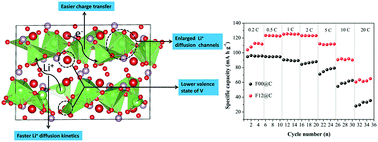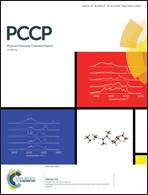F-Doping effects on carbon-coated Li3V2(PO4)3 as a cathode for high performance lithium rechargeable batteries: combined experimental and DFT studies†
Abstract
F-Doping effects on polyaniline-derived carbon coated Li3V2(PO4)3 (Li3V2(PO4)3−xFx@C) as a cathode for high performance Li rechargeable batteries are systematically investigated with a combined experimental and DFT theoretical calculation approach. The results clearly indicate that the doping amount has a significant impact on the rate capability and long cycle life. The optimal material (Li3V2(PO4)2.88F0.12@C) delivers 123.16 mA h g−1@2C, which is close to the theoretical value (133 mA h g−1), while showing a greatly improved cycle stability. Rietveld refinements show that the F− doping does not obey Vegard's Law, which may be attributed to the generated lower valence of V ions. AC impedance spectroscopy shows that the F-doping can achieve faster interfacial charge transfer for higher reaction reversibility. DFT calculations confirm that the lower V2+ (t2g↑)3 does exist in Li3V2(PO4)2.88F0.12, and the mean nearest neighbor Li–O bond length also increases for faster electrochemical kinetics, and further reveal that there is a tendency for a transition from the insulator to the n-type semiconductor due to the F dopant. The combined experimental and calculated results suggest that F-doping indeed greatly facilitates the charge transfer rate of the Li+ insertion/de-insertion process for better reversibility and enhances the Li+ diffusion rate to access the reaction sites, thus resulting in high rate capacity and cycling stability. This work not only offers a facile and effective approach to synthesize high performance Li-ion battery material for very promising practical applications, but also discloses scientific insights on element coating and doping to guide the electrode material design for fast electrode kinetics in energy storage devices.



 Please wait while we load your content...
Please wait while we load your content...